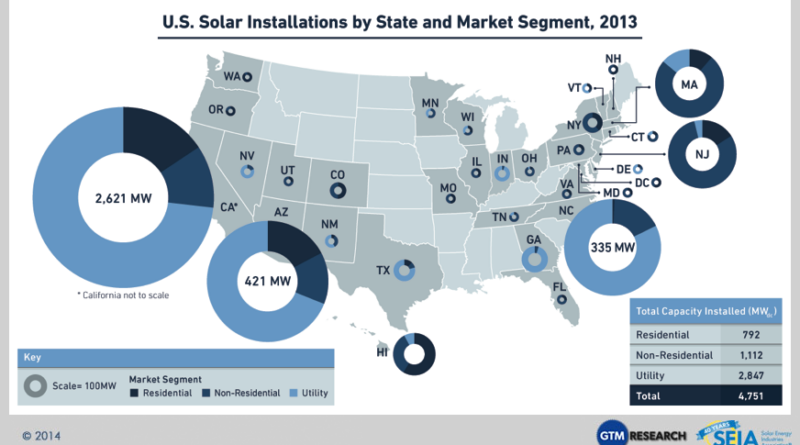Solar Now Mainstream In US, According To SEIA’s 2013 Market Review
Sign up for daily news updates from CleanTechnica on email. Or follow us on Google News!
Originally Published in the ECOreport.
When Rhone Resch used to get together with the CEOs from other energy sectors for lunch, he always felt like the little guy at the table. He might have been President of the Solar Energy Industries Association (SEIA), but it was the major players—like gas and oil—that used to pick up the tab. Those days have gone: around 29% of all new electricity installations during 2013 were solar; the industry is now mainstream.
According to statistics in the newly released Solar Market Insight Year in Review 2013, solar was the second largest source of new electricity generating capacity in America last year, exceeded only by natural gas. 4,751 megawatts (MW) of solar photovoltaic (PV) capacity were installed, and almost half of that in the fourth quarter.
There was also an 80% increase of concentrated solar power (CSP). Around 410 MW of capacity came online during 2013, “kicking off with the 280 MWac Solana project and the Genesis Solar project’s initial 125 MWac phase.”
Solar’s contribution to the energy sector has almost tripled in size in a single year.
“This has been a record shattering year,” said Arno Harris of Recurrent Energy, one of the three speakers who introduced this report to the media. “There were more installations these last 18 months than during the past 30 years. These numbers show that solar will be one of the three technologies that shape energy’s future.”
“We forecast 26% PV installation growth in 2014, with installations reaching nearly 6 GW. Add in CSP and we will pass 6 GW,” said Shayle Khan, Senior Vice President at GTM Research and lead author of the report. He predicted that this growth will continue to be rapid in the residential sector, which has been the industry’s “bedrock,” and the non-residential sector will continue to remain relatively “flat year-over-year.”
After two years of continuous declines, the price for polysilicon and upstream PV components is now increasing. That is because of increased demand, especially in the US, China, and Japan. Modules produced in the 4th Quarter were priced 35% higher a year ago.
The cost of solar installations has also gone down and was 15% lower at the end of 2013 than 2012.
Solar companies have been trying new financing options:
- NRG Energy took its first YieldCo public, generating a tradable, dividend-producing security that contains both utility-scale and rooftop solar projects, as well as fossil fuel assets.
- SolarCity successfully launched the first distributed solar securitization, worth $54 million.
- There are also opportunities to invest in solar via crowdfunding or community solar.
There are now 140,000 individual installations in the US, with a market value of about $13.7 billion.
“Increasingly, solar is not bound by its cost, but rather by its role in the electricity sector. And as solar continues along its path toward the mainstream, its integration with the broader electricity market from a technical, market, and regulatory perspective will become one of the most important issues in the industry.”
Disputes between utilities and solar advocates have sprung up in numerous states and, so far, the solar market has been relatively unscathed. There have been significant net-metering wins, but the threat of stricter net energy metering regulations is not over. Some key decisions that will effect the energy market for years to come are liable to be made during the next two years.
California continues to lead the industry. Though subsidies have dried up, there are no signs that the industry is slowing down. More than half of last year’s installations occurred in California. In fact, the state installed more solar last year than the entire United States did in 2011.
Arizona didn’t live up to its 2012 total of 710 megawatts. On the other side of the spectrum, however, North Carolina, Massachusetts, and Georgia had major growth years, installing a combined 663 megawatts, more than doubling their combined total from the year before. On the whole, the top five states (California, Arizona, North Carolina, Massachusetts, and New Jersey) accounted for 81% of all U.S. PV installations in 2013.
Follow me through Facebook, Twitter or Google+.
Chip in a few dollars a month to help support independent cleantech coverage that helps to accelerate the cleantech revolution!
Have a tip for CleanTechnica? Want to advertise? Want to suggest a guest for our CleanTech Talk podcast? Contact us here.
Sign up for our daily newsletter for 15 new cleantech stories a day. Or sign up for our weekly one if daily is too frequent.
CleanTechnica uses affiliate links. See our policy here.
CleanTechnica's Comment Policy
